











Phoenician religious panorama is not unitary, it is made of particularisms, and there were numerous differences between cities. The fragmentary aspect of the Phoenician political context has influenced the establishment of a local pantheon at each city-state, which autonomously organized the public ritual with feasts and celebrations. These urban pantheons presented some common characteristics: organization deities as "triads", which did not exclude the presence of other less important gods.
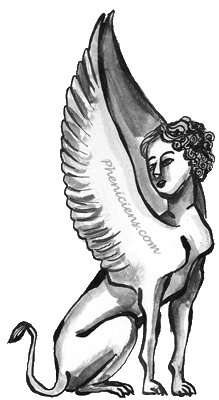
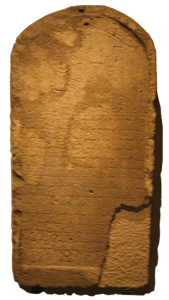
The pantheon of Goubal (Jbeil/Byblos) was dominated by the god El, the supreme Phoenician god associated with Ra, the god of Pharaoh, which clearly reflects the Egyptian influence. Then there is the goddess, whose cult is very old, referred to as "the Baalat", the city mistress, the "Lady of Byblos". Its iconography, characterized by Egyptian symbols, associates her to the Hathor-Isis. And last but not least, the young god represented by the handsome Adon (Adonis), god of renewal and regeneration.
Documents related to this "Lady of Byblos", suggest that she was the protectress of the king and the guarantor of power. The most explicit reference is the stele of Yehaumilk king of Byblos, it shows the goddess on a throne, wearing a tight dress like the Egyptian goddesses. However, the most important deity still is Adon (Adonis for Greeks); his original Semitic name means "lord". He is the "god who dies". The celebrated festival in his honor consists of public demonstrations of struggle, the tonsure of women, ritual prostitution and liturgy of the "rebirth" of Adon. This god's cult, later reappears among other peoples and especially in the Greek mythology, and is related to the belief of a life after death.
In Sidon the triad of Baal, Astarte and Echmoun were worshiped. Though the name of the first divinity is common and generic, the worship of the goddess Astarte was derived from the ancient Semitic (Syrian-Palestinian) tradition and was widespread throughout Phoenicia, known in the Code of Hammurabi, as the "goddess of fighting and war". The Bible attributed to her links with fertility and love, where she is considered the "queen of heaven" (Jeremiah 7:18 / 44:25). Or as "the mistress of the sky" on the tablets of Tell El-Amarna in Egypt. She was later assimilated to the Greek Aphrodite and Venus among the Romans. The third divinity Echmoun is the principal god. His name is linked to its Semitic origin that refers to "the Oil", whose protective and curative properties were of great importance in the ancient civilizations. Several historical documents and traces have shown, this god as a young man carrying a stick in his hand surrounded by two winged serpents. Among these documents a leaf of gold found near the temple of Echmoun, or a coin discovered in Beirut ... Echmoun was assimilated later, to the Greek god Asclepius, then Aesculapius among the Romans. His representation is presently known all over the world, as the symbol for a majority of organizations and medical professions. In Sidon Echmoun had two temples: urban, as "Baal of Sidon" and another outside town, in the area of Bostan ech-Cheikh.
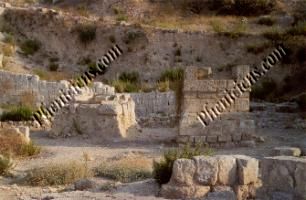
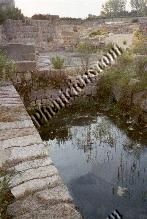

In both locations, Echmoun was portrayed side by side, with Astarte. The legend described by Philo of Byblos, mentioned a youngster handsome man from Beirut, who often went around Sidon to practice his passion for hunting. Astarte saw him and fell immediately in love with him. Echmoun, in order to escape the solicitations of the goddess, mutilated himself with an axe, but he died from his injuries. Astarte, overwhelmed by sorrow, went looking amongst the dead and raised him by her regenerative capacities. She made him the \“god of healing and medicine\”. He became, to Sidon, which was Adon (Adonis) to Byblos, the god "who dies and reborn" each spring. In the temple of Bostan ech-Cheikh, a pond was constructed, it had a ritual function, also called "the pool of Astarte", in which is located an empty throne, carved from a single granite block, also known as the "throne of Astarte". This basin, like all other sub-basins, was fed by the Ydlal source mentioned in the inscriptions of Echmounazor.
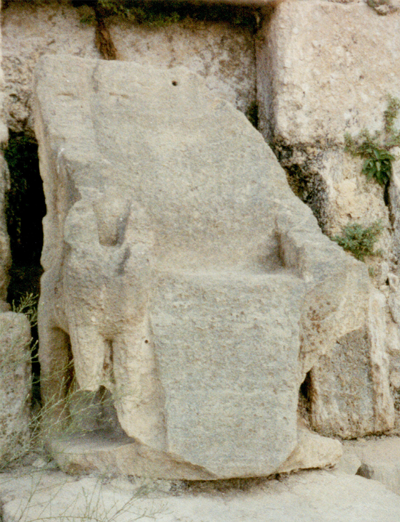
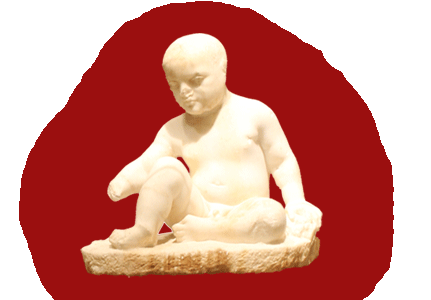
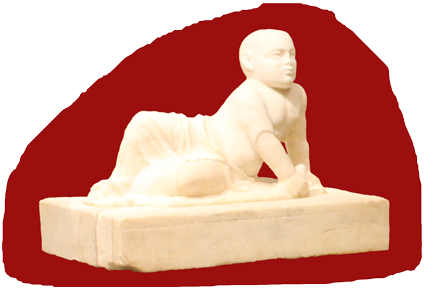
Several offerings were found in this place, especially statuettes of children. This presupposes that Echmoun was specialized in children's healing. On the pedestal of one of those statues, offered by a son of a Sidonian king, a writing engraved in Phoenician seeking protection of "his lord Echmoun".
Sidon was also famous for its sarcophagi and particularly the anthropoids. Several have been found during archaeological excavations in the necropolises of Ayaa (four of whichwere white marble), and in Magharat Tabloun including the sarcophagus of the King Echmounazor. Twenty-five others were found during renovation work of the Evangelist High School ... The richness of these sarcophagi, assumes that the city of Sidon constituted a production center of these items. They were almost exclusively carved in white marble. This is from Sidon, that the uses of anthropoid sarcophagi were propagated throughout the Mediterranean world. Sidon sarcophagi are today in the various museums in the world.
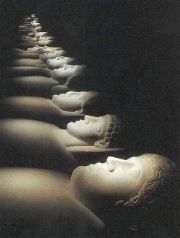
The gods Baal, Astarte and Melqart symbolized the triad in Tyre. Melqart was the tutelary power of the city, his name means "king of the city". His cult dates back to the tenth century BC when Hiram, King of Tyre, had established a sanctuary in honor of the god, and spread his veneration. Melqart is considered as the founder of the city and the protector of its economic activities. Due to the presence of a strong component of Tyre with the Phoenician expansion in the Mediterranean, the cult of Melqart was exported all over the known world: from Gibraltar to Cyprus, and through North Africa, the Italian islands, the Aegean islands… He had a pivotal role in relations between metropolis Tyre, and its colony Carthage. Each year, during a festivity (known as the Egeris by Greek authors), Tyrians and Carthaginians celebrated together in Tyre the resurrection of the god Melqart, which was another expression of the "god who dies and reborn". The Astarte of Tyre has the same qualifiers as its Sidonian neighbor: the goddess of love and fertility. Aside from these two central figures (Melqart and Astarte), the Tyre pantheon is a series of varied divine entities such as: Shamem Baal (Lord of Heaven), Baal Shaphon (master of winds and ocean currents), and Baal Malage (Lord of sailors).
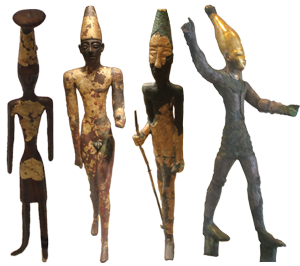
A series of minor divinities were beside the main triads. So, Khousor reigned on the seas, while keeping an eye on the punctual progress of the seasons, Reshef was the god of thunder and lightning, Aliyan of sources and groundwater, Dagon the god of wheat, Chadrapa protector of physicians and Hijon of artisans. Sydyk and Misor personified justice and righteousness...
Phoenician cult was accomplished by the sovereign (at least in the main cities: Tyre, Byblos and Sidon), assisted by priests grouped into colleges and led by a "chief priest". This personage was empowered with a considerable prestige. In Tyre, for example, the high priest of Melqart was, according to Justin the Roman historian, the second personage of the city after the king. His tremendous wealth had, according to the legend of Elissa-Dido, caused the jealousy of Pygmalion, King of Tyre, who ordered to assassinate his uncle Acherbas (priest of Melqart) and caused the exile of Elissa, his sister and Acherbas's wife, who later became the foundress of Carthage.
Several rites and sacrifices were practiced in various Phoenician cities. Among the most famous, is the sacred prostitution in honor of Astarte. Some ancient sources specified: either that prostitution was an exceptional rite practiced by the priestesses of the temples of Astarte and reserved for foreign visitors, or, in some cities, not only these priestesses, but all women were, once in their lives, submitted to that practice. Recent interpretations exclude any direct link with fertility rite of nature and propose a much more prosaic explanation: sacred prostitution could have been a way to fill the coffers of the temple.
Other rituals also existed, for which the faithful were to bring offerings to the temple or sacrifice animals, in exchange for a favor, such as health, healing, descendants, an abundant harvest, the victory over the enemy etc. The most celebrated rite was human sacrifice, especially of children. The Bible mentions the areas named Tophet, where the sons and daughters of Phoenicia were burned. Attested primarily in Carthage, the biggest colony of Tyre, the Tophet is an open air sanctuary situated outside the walls, which contains some cinerary urns and stone steles. In the urns, child bones were found. The East Phoenician does not offer testimonies that would corroborate those sacrifices. The same biblical quotation could refer to a single initiation rite of sacrificial purification. The Tophet could simply be a children necropolis.